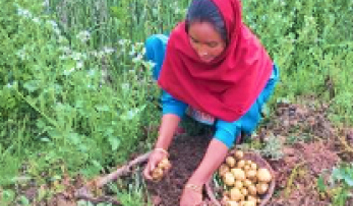
Radha Devi: Kitchen Garden Case Study
Sowing Seeds of Self-Reliance: Radha Devi’s Kitchen Garden Revolution
In the picturesque village of Rajiana, Kangra block, Himachal Pradesh, Radha Devi’s family of four leads a life deeply rooted in agriculture. Their diet primarily consists of what they cultivate and what the market offers, constrained by their sole income source – her husband’s Rs. 6000 monthly earnings as a tractor driver. With two sons, one in higher secondary and the other pursuing graduation, the rising educational expenses have tightened their financial situation, making it challenging to meet basic needs and diversify their diet beyond the limited farm produce.
Radha, an active member of CORD-Facilitated Mahila Mandal and a Self-Help Group, finds herself in a dilemma. Her family’s diet lacks variety, relying heavily on grains and seasonal vegetables either grown on their farm or bought from the market. The escalating market prices for vegetables have made it increasingly unaffordable to bring diversity to their meals. She owns a 1.5 kanal (576 m2) plot near her house, ideal for vegetable cultivation, but the threat of stray cattle and the high cost of wire fencing render it underutilized, leaving Radha in a quandary over how to best use this land to benefit her family’s diet and finances.
The program’s pivotal intervention for Radha Devi involved installing wire fencing around her land and setting up a plastic water tank for irrigation, fostering the growth of a flourishing kitchen garden. This initiative, which included distributing various vegetable seeds and teaching effective planting methods, has transformed her 1.5 kanal plot into a vibrant source of diverse, home-grown produce.
Intervention and Results
Radha’s kitchen garden, now teeming with turmeric, garlic, onions, potatoes, papaya, green leafy vegetables, and tomatoes, has significantly enhanced her family’s diet, reducing their reliance on market-bought produce. More than just a source of fresh ingredients for her meals, the garden stands as a testament to self-reliance. It’s not only fulfilling her family’s nutritional needs but also promises an additional income stream from selling surplus produce. This green endeavor has successfully turned Radha Devi’s family into proud cultivators and sellers, marking a triumphant step towards financial independence.
Enhancing Nutrition and Income through Kitchen Gardens
The primary goal of CORD’s nutritious kitchen garden initiative is to support daily nutrition and increase income for rural households. By enabling families to cultivate basic vegetables in their backyards, these gardens serve as a vital source of both sustenance and additional revenue. The program focuses on small-scale gardens, conveniently located near homes, to ensure food and nutritional security at the household level. Technical assistance and resources, including wire fencing and a variety of vegetable seeds, are provided to six selected impoverished households. Special attention is given to families grappling with severe acute malnutrition and tuberculosis. These gardens not only fulfill the vegetable needs of each household but also offer an opportunity to generate extra income by selling surplus produce.
